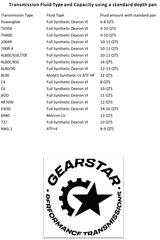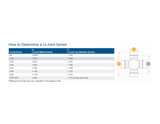Automagic Transmissions- Computer Controls for Electronic Overdrives
When it comes to applying the latest technology to street rods some of us are more enthusiastic than others. If nuclear powerplants suddenly became available you can be sure Brennan would shoehorn a reactor under the hood of his highboy. Then there are those of us who are skeptics. Not to name names(editor’s note: this from a man whose calendar ended in 1967!), we all know guys who held back on the newest whatchamacallit until it was proven, who chose to stick with eight-tracks because cassettes would bever catch on, and whobelieved points were superior to electronic ignition because you could always adjust those simple breakers out in the middle of nowhere, but if a module died you’d be stuck (editor’s note: Ron is unaware that you can purchase extra modules to place under the seat – where he keeps his Cheetos!).
The truth is today most of us have been listening to CDs for some time, haven’t changed a set of points in years, and have come to believe computers and hot rods are no longer mutually exlusive. Little black boxes of some sort are in and run almost everything in a contemporary automobile and there’s no arguing that performance and longevity have improved as a result and more of that technology is finding its way into our hobby on a daily basis. One of the most recent advancements to impact our world are the variety of computer-controlled automatic transmissions that are now available.
With the introduction of automatic overdive transmissions, rodders found they could have the best of both worlds; a transmission with a low first gear for off-the-line acceleration, and an overdrive gear of more economical highway cruising. When first introduced, these overdrive transmissions used controls that were similar to their three-speed predecessors, mechanical throttle valve linkages, vacuum switches, internal governors, and so on. But it didn’t take long for the OEMs to figure out a better way was to use a computer that allowed the engine and transmission management systems to communicate with each other. Unfortunately, for our purposes that meant that installing computer controlled transmissions in street rods was going to require stand-alone electronics.
Much like the early retrofit fuel injected systems, most of the first aftermarket transmission controllers had to be programmed with a laptop and for may rodders that was enough to make stay away; after all we’re talking about some guys who still have clocks blinking on their VCRs. Fortunately there are now controllers that are plug-and-play, like the Compushift II from HGM Automotive Electronics. The guys behind HGM today are Mike Hoy, who has been in the transmission business since the ‘60s and Guy Cardwell, an electrical engineer, who Hoy describes as the sharpest guy he knows in electronics.
As Hoy explains it, without a controller these modern transmissions are literally “brain dead.” However, with a properly designed management system they are tunable to provide high performance for a variety of applications. Computers offer total control of shift points, shift quality, and converter lockup. And from our stand point the best thing about them is they totally eliminate finicky and problematic throttle cable adjustments. In simple terms, these computers control the transmission based on the input they’re provided from a variety of sensors, such as:
Transmission Output Shaft Speed (TOSS) Sensor: As the name implies, it measures the speed of the driveshaft. This sensor can also supply a signal for an electronic speedometer. However the TOSS signal for the computer should never be connected to the speedometer; there is a wire called “reproduced TOSS” for that purpose.
Throttle Position Sensor (TPS): Again, as the name implies, this sensor detects the position or opening of the throttle. In the case of engines with electronic fuel injection the existing TPS can be used. For carbureted applications HGM offers an add-on TOS with a bracket to mount it and a link to connect it.
Manual Lever Position Sensor (MLPS): Ford uses this sensor, or a variation of it, to tell the computer what gear the transmission is in. On GM transmissions this function is done internally. While on the subject of Ford overdrives, they so have some unique features that we should point out. Like most transmissions Park, Reverse, and Neutral are standard shifter positions, but unlike many other four-speed overdrive automatics there are only three other shifter positions – D, which allows the transmission to shift through all four gears; 2 which locks the transmission in Second gear only (the vehicle starts in Second and stays there); and 1, which locks the transmission in First and keeps it there. What’s missing is a Third gear position, but while it may not be on the gearshift indicator it is available with the push of a button. The Compushift II comes with what is called a “cancel switch”, which prevents the transmission from shifting into Fourth (however the converter will still lock).
Installing the Compushift II controller is simple enough. It should be mounted way from any sources of extreme heat, and that includes the heater outlet. All the wires are clearly labeled; all the plugs are dedicated and will only fit in the proper place, but do yourself a favor and read the instruction before you begin installation. But if you have any questions the helpful tech guys are just a phone call away.
While HGM Compushift II computer is an extremely smart device, it’s something simple that will dumb it down-a bad ground. After everything in your street rod is painted, plated, and powdercoated, it can be tough to find a good spot to ground electrical components, but a good ground is absolutely essential to the proper operation of the HGM system (as well as every other electrical devise). That’s why HGM recommends grounding their system directly to the block (but the connection point still needs to be clean, bare metal.)
Once installed no laptop is needed to program the Compushift II. The system is delivered with factory-set programming for a wide variety of transmission and engine combination; however a setup screen can be used to input information, such as number of engine cylinders, gear ratio, tire diameter, and more, if necessary. In addition a PC can be connected via the USB port for system software updates and advanced tuning if desired.
There’s no question that a computer offers the most precise control of today’s incredible overdrive automatics while allowing alterations for special circumstances. The Compushift II can be programmed to deliver neck-jerking shifts under full throttle, yet provide smooth drivability during light throttle and cruising – that’s real automagic.
Oh, by the way, anyone want to buy a box of eight-track tapes?


